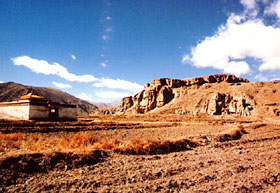| |

Through the 7th to 9th centuries in Tibet, southwest China, there existed a famous regime -- the Tibetan Regime. Its first ruler, King Songtsen Gambo (617-650), was an accomplished leader. Unifying all the tribes in Tibet, he made Lhasa the capital. He then developed production, created the Tibetan language, made laws, set up official and military systems, and established a Tibetan slavery system.
In order to absorb central China's advanced culture, Songtsen Gambo married Tang Dynasty's Princess Wen Cheng in 641, sent Tibetan aristocratic children to Chang'an (capital of Tang) for study, invited Han people to take charge of his official documents and letters, dispatched his people to learn central China's production techniques and technology, and otherwise promoted economic and cultural exchange between the Han and Tibetan areas.

Songtsen Gambo made great contributions to the social, economic and cultural development of the Tibetan region, to good relations between Han and Tibetan people, and to formation and development of a multi-national China.
According to such Tibetan history books as Grand Ceremonies of the Wise, Chronicle of Tibetan Kings and Officials and Chronicles of Tibetan Kings and Clansmen, there were altogether 35 tombs of Tibetan Kings and concubines, divided into groups, with each group centered in a separate area.
The largest group of known tombs was located on the Mure Mountain at the southern bank of the Yarlung Zangbo River, southwest of the Zongsam Mountain and beside the Yarlung River (today under the jurisdiction of Qongyai County in the Tibetan autonomous region). Surrounded by open ground and benefiting from moderate weather, rich soil, and beautiful landscape, this area with its favorable natural conditions was the birthplace of the ancient Tibetan people and the old home of the founding King, Songtsen Gambo.
After the King chose Lhasa as a capital, this area became his base to strengthen his regime and solidify his rule, and was accorded special attention. It may have been nostalgia, as well as the favorable and rich natural conditions, that decided Songtsen Gambo on this area as his burial place. Later quite a few other Tibetan kings were buried here.
Scattered all over Mure Mountain, nine recognizable mausoleums cover an area of 3 square kilometers. Similarly shaped, they were all high, square earth heaps with flat tops of piled stone and pecked earth, imitating the early tomb styles of central China. But now, after over a thousand years of wind and weather, their characteristics have changed; some have become rounded and flat on top.
According to historical documents and inscriptions on the memorial tablets, only three of the nine tomb occupants have been identified:

 Tomb of Songtsen Gambo Tomb of Songtsen Gambo
A surviving inscription at the Songtsen Gambo tomb reads that was once situated at the mouth of the Qingpu Ravine (after several centuries the tomb now is a huge square grave at the center of a plain facing a distant Qongyai County seat). The tomb appears to have been square. The interior had nine chambers, the main one a Buddhist hall, at the center of which stood a 7-or 8-chi-long (3 chi = approx 1 meter) coral lamp that burned day and night. The four corner chambers stored various treasures. The inner tomb wall was made of square stone slabs covered by a thick layer of earth, which in turn was covered with broken stones, forming an earth hillock.
The tomb door opened to the west and each side was 100 paces long and over 6 zhang high (1 zhang = 3 1/3 meters). It is said that under the tomb was a spacious underground palace, storing statues of Songtsen Gambo, Sakyamuni and Bodhisattva Guanyin; numerous everyday utensils inlaid with gold, silver, jewelry and agate, and amour and weapons of the day.
Originally a sacrificial temple was atop the tomb, consisting of 20-odd soul towers and four small-sized halls on the four sides. Within the temple were statues of Songtsen Garnbo, Princess Wen Cheng, Princess Chi Zun, Minister Ludongzan and the creator of the Tibetan language, Tunmi Sangpuquan. Over time, the original buildings deteriorated, but in recent years the temple and statues have been restored and a continuous stream of visitors and worshipers pay tribute to this outstanding Tibetan King who devoted himself to the development of Tibetans and unity between the Han and Tibetan people.
|
|
